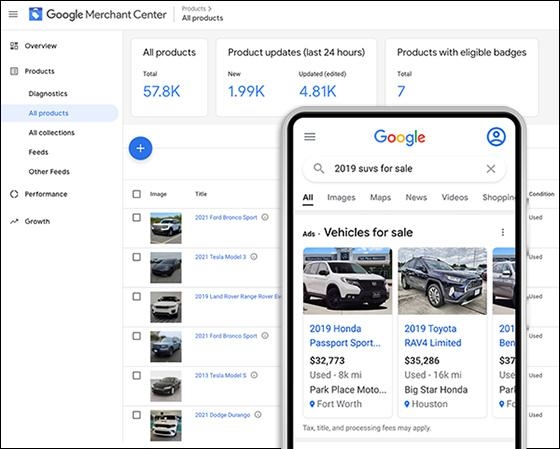Google Launches Automated Automotive Ad Unit

Google vehicle ads now provides a new ad format on Search that shows nearby cars for sale. The advertising unit, announced Friday at the National Automobile Dealers Association (NADA) Show, aims to help more consumers who turn to the web to look for cars.
The ads initially launch in the United States, but Google plans to add more countries soon.
The automotive text ads running in search are more focused on brand awareness, but these will enable consumers to search for inventory on dealership sites from Google Search, said Stephanie Shum, director of product management, retail and vertical ads.
“The data comes from a vehicle feed,” Shum said.
For example, a search for a 2019 SUV might return several options. The ads are designed to allow auto advertisers to promote their entire vehicle inventory on Google search — a format that includes an image of the vehicle, make, model, price, miles and advertiser’s name.
Dealerships create a vehicle-inventory data feed and connect it to Google Merchant Center.
This feed contains the details about the vehicle inventory, such as make, model, price, mileage and condition. Google uses the details to match shoppers with the most relevant cars as they are searching.
By using Merchant Center, dealerships can keep track of key inventory and ad performance insights, such as how many clicks a particular car gets during a selected time.
“As we created this format, we took the information known to be important to car buyers,” she said. This is what makes the ads different, she added.
While 89% of new car buyers researched their new vehicle online In 2021, 16% of new car buyers purchased their car online — up from 1% three years prior.
Google pointed to several terms that have seen explosive growth. Searches for “most expensive cars” have grown globally by more than 2000% year-over-year, while searches for “electric vehicle” have grown globally by more than 100% YoY, and searches for “3rd row” have grown globally by over 70% YoY.
Advertisers that are early adopters — complementing their existing Search campaigns with the vehicle ads in beta — saw more than a 25% average increase in conversions.
Asbury Automotive Group, for example, needed a solution to meet the demand of shoppers searching for cars online. The team created a vehicle feed, a listing of all their inventory with descriptive attributes, like make and model, and the dealerships where they’re located.
After creating that feed, they used vehicle ads to promote their used car inventory on Search. As a result, Asbury drove a 35% increase in conversions and a 12% increase in conversion value.
(4)







